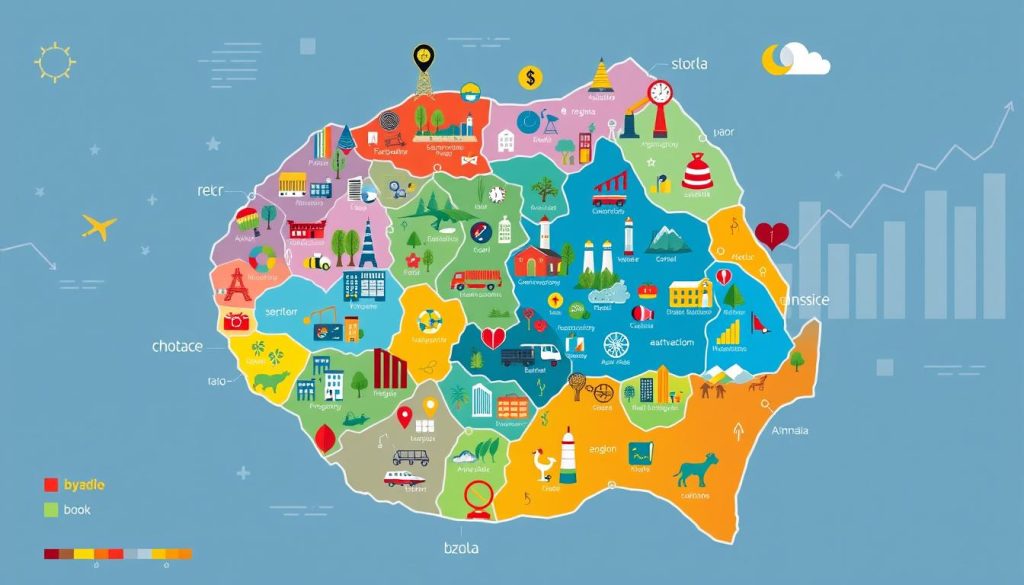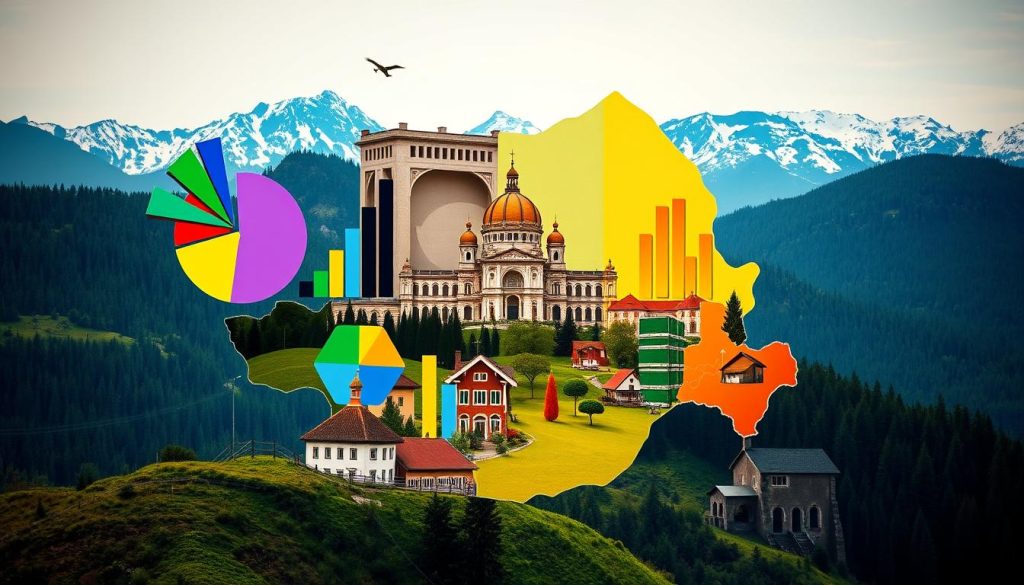Understanding Romania’s economy is key for everyone involved. Structural business statistics help us see important economic details. They show us the big trends and patterns in business across different sectors in Romania.
Romania is a great place for businesses, ranking 10th in the EU by GDP. It has the lowest corporate tax rate in Europe and good double-taxation deals. These facts show the Romanian economy’s strengths and help us plan for the future.
We will look closer at these statistics. They tell us about the types of industries, where businesses are located, and the health of the economy. This knowledge helps us make better decisions and achieve better economic results.
Overview of Romania’s Economy
Romania’s economy is strong, with many economic indicators showing growth and stability. Our country has over 19 million people and a GDP of about $383 billion in 2024. This shows we can adapt well to changing global situations.
Key Economic Indicators
The Romania economic indicators give us important insights. For 2024, our GDP is expected to grow by 2.8%. In 2022, it grew by 4.8%, and in 2023, it was 2.2%. Our unemployment rate is 5.6%, showing a stable job market with 68.7% employment in 2023.
Our inflation rate is 5.3% for 2024, showing challenges in keeping prices low while growing. The government debt is 53% of GDP, and our current account balance is -7.1% of GDP. These figures are key to understanding our financial situation.
Current Economic Climate and Future Projections
The Romania economic climate is positive, recovering from the COVID-19 pandemic. The European Commission predicts a 4% GDP increase next year. This is due to more private spending and big investments.
Our market trends show more investment in infrastructure and digital changes. These are crucial for our economic growth. Looking ahead, we expect a strong rebound in GDP and growth in sectors like agriculture and services. This makes Romania a strong competitor in the EU.
Understanding Structural Business Statistics
We’re diving into the world of structural business statistics. It’s key to the economy’s health. These stats give us a full picture of businesses, showing who they are and how they’re doing. This info is vital for checking the economy’s health.
By looking at these stats, we can spot trends. These trends help shape business plans and guide important policy changes. This leads to growth.
Definition and Importance of Structural Business Statistics
Structural business statistics cover the basics of businesses, like size and performance. This info is crucial for understanding the economy’s different parts. It shows how strong the economy is and where it’s growing.
This data helps businesses improve and governments make better policies. It’s essential for both.
Applications in Business and Policy Making
Business statistics help guide big decisions. They help businesses understand the market and improve their operations. They also help policymakers create growth plans that match economic goals.
Using this data wisely leads to better strategies. This makes the market stronger and more stable. It creates a space for innovation and staying ahead.
Key Structural Business Statistics in Romania
Looking at Romania’s economy shows it’s diverse. Sectors like services, manufacturing, and agriculture are key to its growth. In 2021, services made up 65% of the GDP.
These sectors have seen growth, showing changes in the economy. This change is especially true after the pandemic.
Industry Composition and Performance
The statistics show Romania’s economy is strong and varied. The financial and insurance sectors employ 3.1% of the business economy in 2021. This shows their big role.
There are also many high-growth businesses. They show innovation and strength even when faced with challenges. The data helps us understand how businesses start, survive, and close in different areas.
Geographical Distribution of Businesses
Businesses mainly focus in urban areas, especially Bucharest. It has the most businesses. Romania’s statistics show some areas are more active than others.
This knowledge helps plan better for economic growth. It aims to balance the economy and help areas that need it more.
Business Demography in Romania
The business scene in Romania is vibrant, with different types of companies. Looking at how many start and stop gives us a glimpse into the country’s entrepreneurial journey.
Enterprise Birth and Death Rates
In 2021, Romania saw a birth rate of 10.70% in businesses, close to the EU average. This shows the strong spirit of starting new businesses in the country. On the other hand, the death rate was 8.48%. This balance shows a lively business world where new companies start while others close, showing both challenges and chances in the market.
Trends in High-Growth Enterprises
High-growth businesses are key to Romania’s economy. In 2021, about 1 in 11 businesses were high-growth. They are vital for jobs and innovation, boosting the economy. By understanding these trends, policymakers can create better financial and rules to help these businesses grow, supporting long-term growth.

Impact of EU Policies on Romania’s Business Landscape
EU policies are changing Romania’s business world in big ways. They help innovative companies grow. These changes are key for Romanian businesses to grow in a sustainable way.
Support for Innovative Enterprises
EU policies help boost innovation in Romania. This creates a lively business scene that’s good for our economy. They help with research and getting funding, which grows high-tech areas.
EU funding lets businesses and schools work together. This leads to new tech and products.
Transition to a Green and Digital Economy
Going green is a big focus for Romania, thanks to EU goals. We’re working on cutting carbon and improving digital services. This meets global environmental standards and makes our economy stronger.
Digital changes are also key. They help Romanian businesses stay competitive in a fast-changing market.
Regional Patterns of Specialisation in Romania
Looking into Romania’s business scene shows different specialisation patterns in each area. Cities mainly host tech firms, while rural spots focus on farming and local making. Knowing this helps create better support plans to boost each region’s chances.
Analysis of Regional Business Dynamics
About one-third of Romania’s people live in Transylvania and Dobruja. Walachia and Moldavia also have big populations. Less than half live in rural areas, key for farming, forestry, fishing, and mining.
These sectors are big for Romania’s economy and jobs. Knowing how population has grown helps plan better for these areas.
Comparative Insights with Other EU Regions
Our study shows Romania’s business patterns are similar to other EU areas in some ways. But, different sectors show how each region can handle economic ups and downs. Romania’s unique spots show both strengths and areas for growth compared to EU peers.
Urban areas are more involved in EU projects, linked to their size and population. Horizon 2020 helps create new partnerships, leading to innovative specialisations. It’s important to understand these insights to make policies that fit each region’s needs and support green growth.

Challenges Faced by Businesses in Romania
In Romania, businesses face many challenges. Access to capital and skilled labour are big issues. These problems affect growth and innovation.
Access to Capital and Skilled Labour
Getting capital is hard for many Romanian businesses. This limits their ability to invest in what they need. Skilled labour shortages also hurt productivity and innovation.
To keep up with Europe, better financial tools and training are needed. This will help businesses grow and innovate.
Impact of Economic Disruptions on Businesses
The COVID-19 pandemic and global supply chain issues have hit hard. They change how markets work and affect consumer habits and production. Businesses must adapt to these changes.
Investing in technology and infrastructure is key. It helps them recover and grow. This way, they can handle the tough times better.
Structural Business Statistics in Romania as a Tool for Growth
Structural business statistics are key to growing Romania’s economy. They help us understand patterns and performance. This knowledge is crucial for business leaders and policymakers to make informed decisions.
With 19.41 million people in Romania, the market potential is huge. Bucharest, in particular, has attracted a lot of foreign investment. Romania is also the biggest electronics producer in Central and Eastern Europe. This shows how important these statistics are for spotting strengths and weaknesses in different sectors.
Looking ahead, using these statistics well is vital for Romania’s economy. Even with slower GDP growth due to inflation, we must stay alert to economic changes. By embracing these statistics, we can better understand and tackle challenges, and grab new opportunities.

